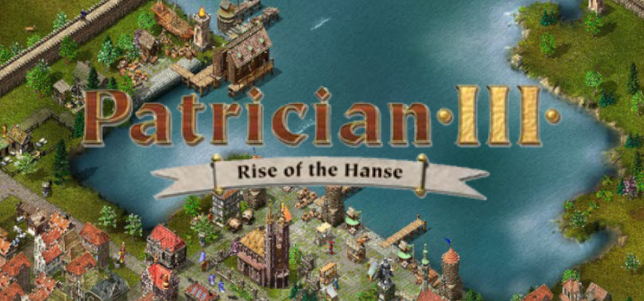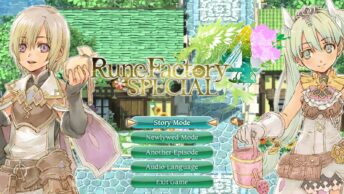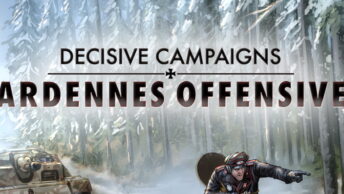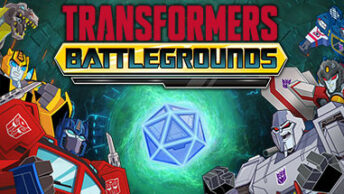Intro
I am going to review Port Royale 4 soon, which was previously previewed by a reviewer who had not played the series before. He talked about enjoying the game, but not quite feeling prepared to talk about it at length for not really playing these types of business-management games that often. I am someone who’s played not only a lot of business management games, but actually have quite an attachment to the sister series of the Port Royale games, the venerable Patrician games. To an extent, this article is an excuse to just rant about why I liked this one particular game so much, but it’s also a good way to explain a certain point that I think gets overlooked in the design of many games.
When someone talks about story in games, they often mean what happens in cutscenes or voice-overs while driving between objectives or text boxes with multiple choice responses. Especially in AAA games, there’s a push to try to equate good storytelling with essentially taking the controller out of the hands of the player and making the game into a movie with motion capture technology famous movie actors giving voicework. In essence, it creates a false dichotomy between “gameplay” and “storytelling” because when the “story” happens, the “game” has to stop happening. (Or worse, you run into the fun of “Ludonarrative Dissonance”, the phenomenon where the story tries to preach a message that is directly contradicted by the way that the game itself is built. For example, Metal Gear Solid has a story whose moral is pacifism, but whose gameplay gives you a dozens of different ways to detonate random guards from rocket launchers to planting C4 directly on their groin when they aren’t looking, as well as a dozen guns you’re very definitely not supposed to use because good boys and girls go tranq gun and stealth runs only. Look at all this fun gameplay you’re definitely bad for trying to enjoy!)
This isn’t, however, the only way a game can, nor even the best way to tell a story in a game.
The way that you build the world, allow the player to express their will in it, and the way that the world responds to the choices the player makes – for good or ill – much more viscerally tells a story about the world and the way it works by letting players explore the world freely and learning to shape their thinking to the world around them. Dark Souls, to take a famous example, has far more emotional impact on the player through the way that its world builds tension for punishing the tiniest lack of attention to the world around you than it draws you in with the actual scripted dialogue. The story of the world is expressed in being stabbed from a monster in a blind corner, falling through a pit trap because the player overlooked an obviously out-of-place piece of flooring, or getting eaten by a mimic, as well as the simple aesthetics of the ruined world itself you traverse. The story the landscape and gameplay impart stick with people far more than the exposition dumps about cycles of fire and darkness. These mechanics drastically change how you evaluate things in the world, and push players towards a far more defensive and paranoid worldview until they eventually “git gud” and learn the confidence to become bolder and really experience all the game has to offer.
Patrician 3 is the not-at-all-like Dark Souls of business management games. Patrician 3 only has anything you could call a traditional linear narrative in the small movie that plays before you get to the main menu. Everything from then on is either pure sandbox or a sandbox with a mission. The story in the game is purely one of player interacting with world, and learning from how the world reacts to the player’s presence, or even simply to its own under-the-hood mechanics driving reactions to actions taken by NPCs.
Capitalism: A Love Story
Let me run you through roughly what my first experience with Patrician 3 was like…
When you first start out, you have your standard trading game setup – a single starter ship, some cash, and the ability to buy some things low and sell them high somewhere else. Each town has specialties they produce, and everything else, they tend to need to import. You don’t make much money at first, but your forward progress is basically guaranteed so long as you buy where there are specialties and sell where they are not specialties. Cities have the capacity to produce small amounts of their non-specialty goods, but even at the start, it isn’t enough to keep the city fully stocked, creating the need for your ships to supply them.
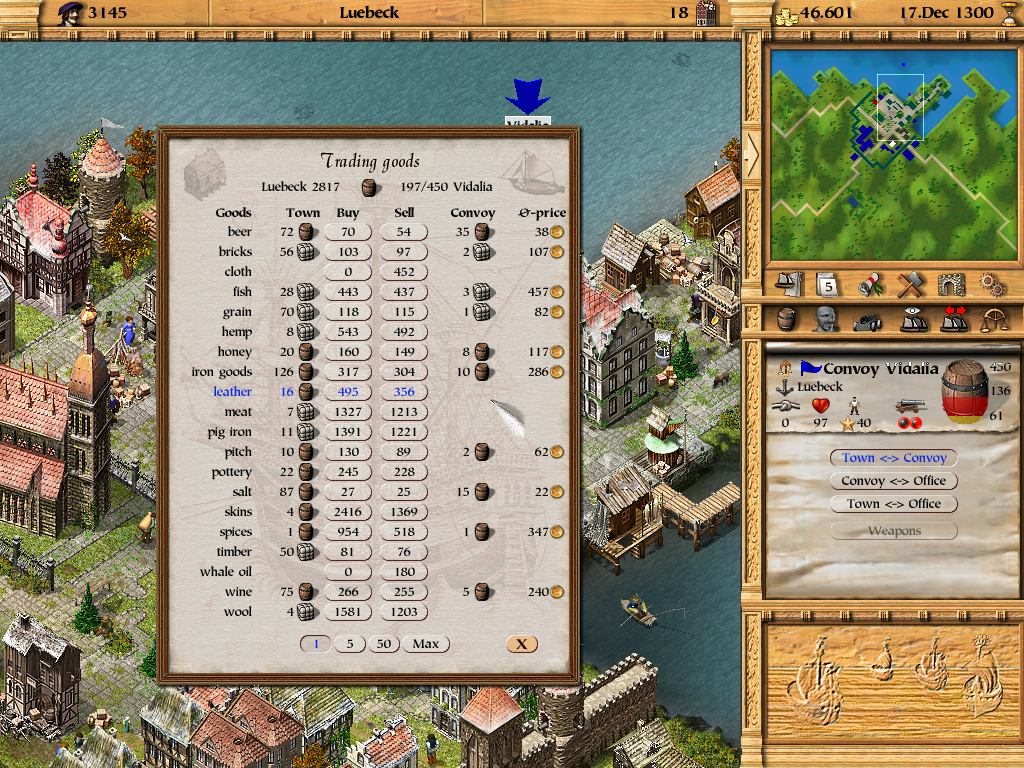
Gradually, however, you start to notice a difference in the cities where you primarily trade. As you trade with a given city more and more, their prosperity will rise so long as you keep the city supplied in its needs. This will cause more and more people to immigrate to the city “from the hinterlands”, as the game’s manual put it. (This is totally banal in Patrician or Rise of Venice, but it’s worth sticking a pin in when talking about Port Royale.) The more people move in, however, the more cities rely upon their specialties and trading for more goods. Cities prefer to have at least 20 days’ supply of any given type of good on hand, and prices rise and prosperity lowers the shorter on supply they get, but the more people live there, the larger a quantity “20 days’ supply” becomes. Due to this, you can sell more of a type of good to the same city (preventing the need to sell what you bought in one city to several cities down the chain just to make a profit), and often can sell the good for a higher price, because the more need isn’t being met, the higher the price they will pay.
As you gain wealth, you can start to build houses and factories in the towns where you have built offices and warehouses that serve as hubs for your trading empire. This adds an element of city building to the game, as you can build housing, play landlord, and then hire your tenants in your factories to control the whole chain of production yourself. Needless to say, this is the key to much greater profits, as if you are the one that owns half the iron mines in the Baltic, you can never again be cut off by another trader selling off iron just before your own ship get to port.
The building up of these cities is slow and gradual, but because you tend to trade in small circuits around a specific hub you are building up, you tend to only see how those particular towns are doing, and get used to the prices those towns are offering.
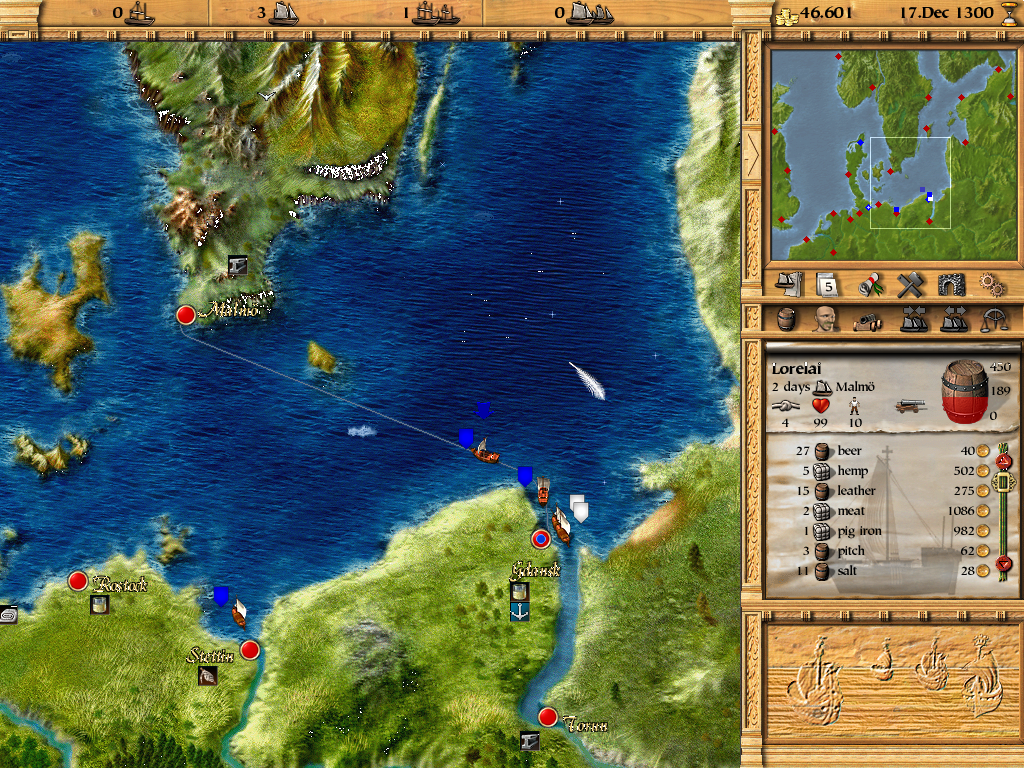
This made for a small shock when I went further afield from my built-up comfort zone to ports like Novgorod on the far east of the map, where I found that the cities were practically deserted, and the markets had little demand for new goods. It was then that the organic nature of this simulation really struck me. I had been building up the market in the cities I was trading in or based in, making them more and more attractive markets, while the towns I had yet to travel to languished from lack of trade, and were comparably less enticing to trade with, creating a virtuous cycle for the cities I already traded with, and a vicious cycle for those I did not. It would take serious work to build up these further cities to the level of prosperity of the towns I had traded with previously.
Does this cycle remind you of anything you perhaps learned in school? This game is a historical simulation set around the turning point between the Middle Ages and the Renaissance, and it essentially is a game about how a capitalist system based upon specialization overturned a stagnant feudal system based upon subsistence agriculture. There is only nobility in the profession of being a merchant in this game. You’re a job creator! Your building low-class housing and factories to stuff the peasants that live there into only creates more jobs and prosperity for everyone. (In fact, donating food to the church is a game mechanic that exists to get homeless beggars to flock to your city as a means of finding more unemployed people to hire and stuff in your tenement housing. Even charity exists purely in the context of increasing productivity.) The price of goods stabilizes as you trade with a city, you just make more profit by producing at lower and lower costs by increasing productivity or cutting out the middle man, plus everyone is more wealthy to start with, so they don’t mind paying a little more for daily needs.
This is, essentially, one of the most full-throated endorsements of free market capitalism I’ve ever seen in a game. Even in other games like Railroad Corporation, which are also set in a historic time period and explicitly show the rise of industry and trade in that time period are often very tongue-in-cheek, pretty much showing the owners of these corporations as the robber barons they are viewed as today. In Patrician, however, everybody wins.
The concept of exploitation does not exist in Patrician. Wages are not negotiable. Housing quality and the price of rent are static based upon class, and you just need to have lower-class people you just generously allow to live in poor quality housing for basically no profit at all just because your workers need to live somewhere if they’ll show up to your factory on time. There is no difference in the danger of any given job, as vintners or bakers and whaling ship crews or miners are treated as the same in spite of real-life dangers those jobs would actually pose. You never squeeze smaller businesses out of business (outside of turning to piracy or war), all new businesses just keep adding to the communal marketplace and expand the market further. Capitalism is purely good, and everyone profits equally. Rising tides truly do raise all boats in Patrician.
It’s worth noting that there actually are ways to play dirty. You can hire pirates to attack ships of your rivals. You can hire bandits to plunder warehouses in town. You can even sack cities directly, yourself. It’s worth noting, however, that in this game, it’s actually really stupid to do so outside of possibly multiplayer competitive games, because a rising tide really raises all ships. You can gain more in the short term with criminal activities, but they carry a serious risk to your reputation that causes serious long-term losses in profits. Plus, these crimes hurt the market that you need to be healthy to buy more stuff from you. The more that even your rivals raise prosperity in a city, the bigger that city’s market is for you to sell to them. The more they invest in expanding a city, the larger the population base demanding your products.
Ultimately, however, even forming a monopoly on a product in the whole Baltic and North Sea area isn’t harmful as long as you are a careful manager, as you have every incentive to keep the supply lines flowing and prosperity up to protect the market you have cornered. In essence, Patrician 3 tells the story of how the best economic model is to let the ultra-wealthy control everything, because they’ll inherently want to make the economy stronger for everyone due to how that is in their long-term best interest. And to be clear, I’m not endorsing this view, I’m just saying this is the viewpoint that the mechanics of the game seem to push the player to adopt. A wealthy player should control the governance of towns because they are clearly competent and demonstrated by their rise to wealth (things like inheriting all that wealth in spite of no talent never comes up here), so the wealthy are clearly the most fit to rule. If someone is not competent, they will lose money and no longer have the power to influence multiple cities as an extranational entity, so it’s all self-correcting in the end.
I’m not sure how much this was deliberate, but it’s unmistakable that the game itself contains a severely pro-laissez-faire capitalist message.
To go back to the beginning, imagine if the game was just telling this to you directly with a linear story cutscene sequence. People complain about ham-handed politics in their games when it’s something just being told to you. When the politics, however, are just encoded in the game mechanics, they are vastly more subtle. You don’t have a dialogue prompt asking you to take a morality meter-shaping choice, you just gradually learn that the game rewards gameplay where you take actions that make the market itself healthier (and therefore make you greater profits long-term), and avoid actions that can weaken the market for short-term gains, like piracy. People shut out a message they don’t want to hear when it is simply read to them, but when they are experiencing the feedback the game gives them for their actions on a mechanical level, they internalize them whether they recognize it or not.
Game vs. Simulation
I should mention that Patrician 3 was made by ASCARON and published by Strategy First, which also made the earlier Port Royale games, but is now owned by Kalypso.
After being bought by Kalypso, games like Port Royale 3 and Rise of Venice had much “streamlined” gameplay. You no longer have a distinction between lower-, middle-, and upper-class citizens, for example, which changed how much demand there was for specific products. In Patrician, lower-class citizens were the workers in your factories, so you needed more of them, but they only consumed cheaper materials and you barely break even charging rent even with full tenement housing, and can lose money as their landlords if not full up. Whereas lower-class citizens eat fish and beer, however, upper-class citizens will consume meat, wine, and spices you need to import on voyages. In Rise of Venice, there is just one type of citizen.
In Rise of Venice, each house provides homes for 100 population, and 100 population is enough to provide workers for 1 factory. You just build a house and a factory at the same time, and reach parity. The mechanics of prosperity are much laxer, so houses are filled almost immediately regardless of your work to keep a city prosperous so long as it isn’t actively facing famine. A factory supports (either directly or indirectly as a raw material used in producing some higher-end good) exactly 2,000 population. Basically, as the world population goes up 2,000 people (meaning: 20 houses are built), there is a market created for 1 further factory for each type of good. (Note that construction materials – bricks and wood – are consumed in building new houses and factories on top of just being consumed by population and as raw materials, meaning they are frequently in short supply.) There are 22 types of goods, and since a house needs to be built for each factory, you are basically always leaving some city short on resources, even if there are some odd events to generate new goods when there’s a serious imbalance. That doesn’t really matter, however, as running out of most goods doesn’t really do anything to most cities except make them suffering a very temporary and meaningless prosperity hit and pay more when you do get around to selling goods to them.
The simpler nature of Rise of Venice (or Port Royale 3, which was much like it) does make it easier to learn and exploit those mechanics… but it also makes it painfully transparent just how “gamey” the game is.
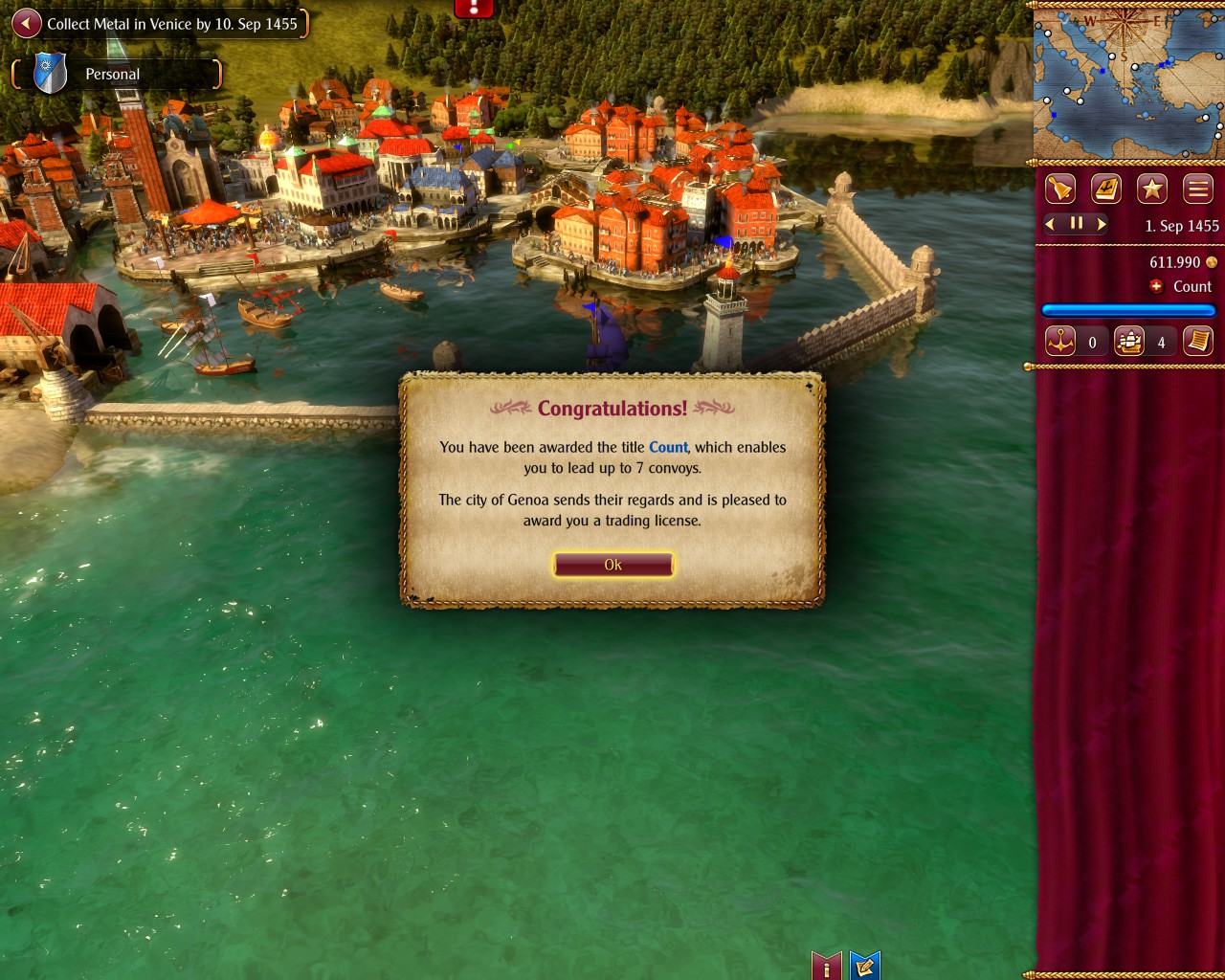
As a game, this can make the game clearer and simpler to understand, however, it also kills the mystique of the world. Knowing that having upper-class citizens raised the amount of meat, wine, furs, and spices consumed, but not quite how much made the world feel much more like a living place, especially when citizens didn’t automatically flood in to fill any vacant housing the instant a house was built just because the prosperity is over 60%. It’s a recurring problem of Kalypso games in particular that many of their simulations are set to be so easy as to kill any of the points that their gameplay seems to be trying to make. For example, Tropico tries to play itself off as a tinpot dictatorship where you use a big personality and lies to hide the many, obvious flaws with your island nation… but the game’s economy is so easy to manage that you can run the whole nation on the profits of a single coffee canning factory, give everyone a minimum wage of $30 an hour, free rent, healthcare, and college for everyone, and rise up to 100% approval ratings as you satisfy literally everyone’s demands for every function of government while lowering taxes. There are no hard decisions when money grows on trees.
This is the problem I had with Port Royale 3 and Rise of Venice – they are definitely well-made games you can be engrossed in, but they lack the actual feeling of being a living, breathing world that grows and reacts to events other than just the player.
In the previous preview of Space Station Manager, I mentioned that the basic default of a management game was that you make money so that you can spend it on property that makes you even more money, which you want so you can spend it on making even more money. It’s simple expansion for expansion’s own sake until you’ve seen everything you can possibly build and just get bored and quit. This problem is much more noticeable when all you are doing is working the game mechanics. When you are reacting to a simulation that feels more dynamic, there’s more to keep your attention even if it is not an explicit gameplay goal. You aren’t playing just to “win”, which is an unattainable goal in many management games that only focus on making money (as no amount of money is ever “enough”), you’re playing to see how the world develops. There are other goals in the story mode of these games, often becoming Patrician or Doge, which involve specific mission goals you need to complete, but your interest in getting a rank up just for its own sake by making 1,000,000 coins after you made 700,000 last time is exceedingly thin if the gameplay itself along the way isn’t interesting.
Playing Patrician, I could get the creeping sense that this was a game that was running on a model that tried to explain how the world worked, at least in the minds of the people who built the game. Playing Rise of Venice, I simply got the sense that they were trying to make a game as streamlined around a gameplay feedback loop as possible, and weren’t very concerned with much beyond that.
Where Are They Now?
As much as I would like to give a glowing endorsement for buying Patrician 3 for yourselves, I have to note it took some work to get Patrician 3 to work on Windows 10. (I actually had to use a registry patch someone in the forums had.) Although I didn’t give it much play myself, I’m told that Patrician 4 is very similar to Patrician 3, but in 3d, and it works just fine on modern systems, so if you are worried about compatibility, go for that.
Patrician 1 and 2 (combined – 2 is much like 3, but 1 feels like an Amiga game) and Patrician 3 are available on GOG.
Patrician 3, Patrician 4, Port Royale 3, and Rise of Venice are all available on Steam. (Note: Patrician 4 and Port Royale 3 are often in bundles nowadays if you keep a look out.)

